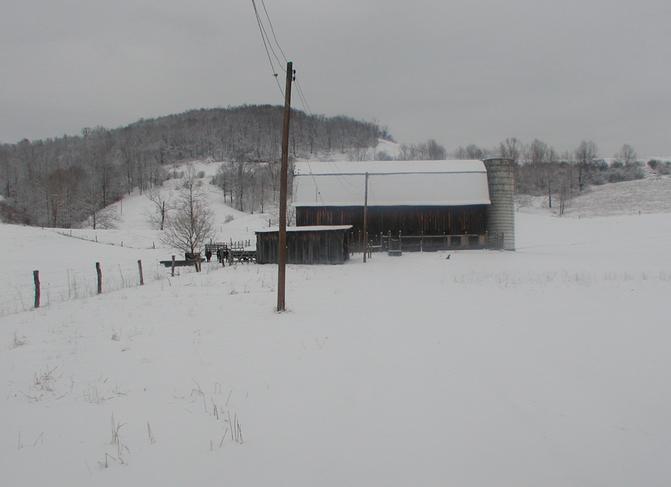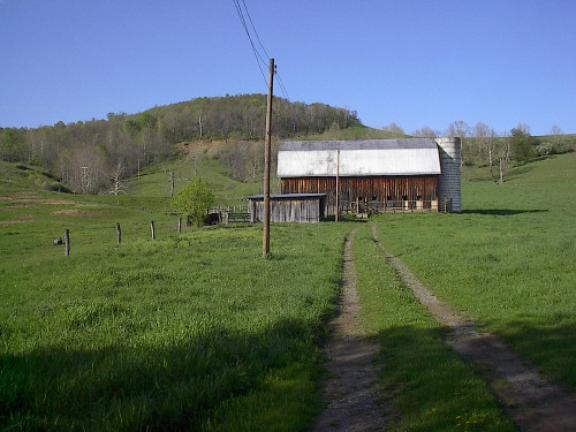
| Next Chapter | Previous Chapter | |
| Chapter 6: The Apple Business | Contents | Chapter 4: Earliest Memories: 3. The Barn |
Mow is a word for a large empty space. As a child, the barn's hay mow seemed huge. It was the second floor of the barn, empty except for 2 x 6 braces from the 2 x 10s that served to support the mow floor. Most of the barn was constructed of "southern pine," imported, semifinished lumber, because the original forest was gone, cleared away except the tops of the hills, and the regrowth we are familiar with now around 2000 had not started up.
The pillars along the central aisle and the beams that ran lengthwise across them were from the old barn that stood in front of the present barn. Hewn from oak, they were stronger than pine, and saved on precious money. The 2 x 10 stringers that supported the floor were oak, also. For the floor Grandpa T. M. used rough lumber, and there were many holes in it big enough for a foot to go through. I remember covering some of them myself when I was a teenager.
After I began to help we seldom got down to the floor of the mow. Hay was put in each year and was taken out as needed. Some winters we went beyond what had been put in the previous summer, some we didn't. Dad made a special effort to use all of the silage each year, because if you left some there was a spoiled layer several inches thick that had to be forked out of the silo and disposed of, with the expense of great labor. Hay was fed in the morning and silage (chopped and fermented corn, kept in the silo) at night.
There was a track along under the ridgecomb of the barn, with a sort of trolley on it. Over the driveway through the barn, was a catch. A one inch rope ran down from the trolley, which was on the catch, through a pulley on the forks (we used the plural, even though there was only one instrument) back up to the trolley, over to the end of the barn through a pulley, down the end of the barn to another pulley, and to a horse outside.
A man on the loaded hay wagon would push the fork down into the load of hay, and push down handles which in turn were connected to barbs which were pulled from pointing down to horizontal. This prevented the hay from slipping off the fork. There was a light rope from the handles up to a ring at the top of the fork. This was long enough to reach back to the operator from any point on the track the fork would reach.
When the fork was loaded the man on the wagon would call to a man or boy at the horse outside, and the horse would pull away from the barn, first elevating the loaded fork up to the track, then along the track to where the load would be dumped. Dumping was accomplished by pulling the small rope, allowing the barbs to go down, and let the hay fall off. Timing was critical, because that controlled where the load fell along the axis of the mow.
The hay dropped as much as twenty feet in our mow. Then (ideally) it was spread back to the walls, an exceedingly hot and difficult job, one which frequently did not get done. The hay would pile up until it would fall over. Sometimes a day or two later we would try to improve the distribution.
In later years we did not bring the hay in on a wagon. Dad got a "buck rake" for the tractor. This was a device which attached to the front axle of the tractor. There were "teeth" about eight feet long of hickory, spaced about a foot apart, enough to make the buck rake ten feet wide. These teeth were about ten inches off the ground in back and were shaped to ride along the surface of the ground in front. The hay slid up the teeth to stop against a framework of pipe in the back. When the rake was full, the front of the teeth could be picked up off the ground by cables which were attached to the tractor hydraulic lift.
(Illustration 5-1)

The barn in winter
You could pile quite a load with this arrangement, which eliminated much of the labor used to get hay on a wagon. When we got to this stage Dad used a "side delivery rake," much better adapted to tractor use. It left the hay in a tangled mess, though. The load was deposited in the driveway of the barn, and a grapple fork with four tines was used, rather than the "harpoon" fork used to unload wagons.
With this stuff you could do little in the mow but push over the piles of hay that fell from the track. More than one winter I remember cutting the hay out of the central part of the mow, under the track, with an ax!
Rarely, when we expected a lot more rain, we would put damp hay in the mow and spread it around to dry. That was a very difficult job, because we didn't want to have thick spots that would spoil. Spontaneous combustion may occur in barns, but I never heard of a real example of it. Mould is the common worry. Anyway, drying hay inside was an advantage of the large barn.
After we quit filling the silo, there was so much hay in the mow that we had to be careful to build the front edge of the hay, next to the driveway so that some would not slide out into the driveway. This meant "tying in" the bunches next to the driveway with bunches further back, sort of like laying up bricks in three dimensions. The art was well understood, because it was necessary to do the same thing with hay on a wagon or in a stack to preserve shape and stability.
These methods were standard in all larger barns of the times. I never heard of an accident in our area although there were plenty of chances for them. Most of the people who did this sort of work were reasonably athletic, in excellent physical shape, sober, conscientious people who took care of their simple equipment. Horses and tractors seemed to be the greatest danger.
The short side of the mow and the long side were connected by a bridge platform about ten feet wide on the south side of the barn. This was always cluttered with things being saved. When Dad got older, and I was away, his footing became less dependable. I built a rail along the side of the platform and put up hardware cloth from a board on the floor of the platform up to the rail.
(Illustration 5-2)

Lost Creek barn in summer, showing the reclaimed strip mine behind it.
One of the things on this platform was an old carboy, a five gallon glass jug, of material once used to spray apple trees. It had a cork closure, and there was a lot of sulfurous looking stuff on the out side that had leaked out. I was told it was "Bordeaux Mixture." Which leads to the next section.
Aside Sometime in 2006 a momentous event occurred in the history of the human race: The urban population, growing for some 8000 years, exceeded the rural population. Over half of us live in cities. In 2008 the earth's population is 6.7 billion. All must eat everyday. The only source of food is plants and animals living on soil and sunlight and clean water. How many people can the earth feed?
| Next Chapter | Previous Chapter | |
| Chapter 6: The Apple Business | Contents | Chapter 4: Earliest Memories: 3. The Barn |
Copyright © 1998, 2006, 2008, 2011 S. Tom Bond (stombond at hughes.net)